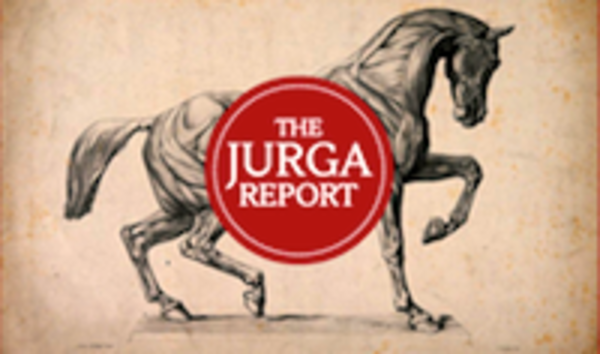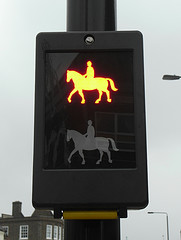
“Hey, slow down!”
How many times have you taken a hand off the reins to signal a car driver to slow for your horse? How far down is that ditch on the side of the road? Do you need to wear a body protector more when you hack on the road than when you school over fences?
You only have to scroll through the horse news to see that riding on the road is dangerous for horses and riders and drivers and their passengers. Horses are unpredictable animals and even the most “bombproof” horse doesn’t deserve to be honked at or harassed by shouting passers-by.

Here in Massachusetts last week, three equestrians reported what they described as a dangerous encounter with a menacing pickup truck driver to the police. According to the Massachusetts State Police log on Facebook, the Sturbridge barracks received a report on the evening of June 7 that a man “had allegedly harassed and assaulted several horse riders on Union Road in Holland with his motor vehicle”.
The troop’s investigation collected witness testimony that “a white pickup truck with a loud exhaust drove by the riders several times. The driver then reportedly drove up behind the riders, revved his engine, honked his horn, and allegedly made contact with the tail of one of the horses. This activity caused that horse to buck and run into another horse, resulting in that rider falling off her horse and landing on the pavement. The pickup truck then left the area.”
The driver was found, arrested, and charged with “Assault and Battery with a Dangerous Weapon (2 counts), Cruelty to Animals, Disturbing the Peace, and Failure to Slow for a Frightened Horse.”
Failure to slow for a frightened horse? Yes, it’s a law on the books in Massachusetts.
At first, I thought it was great that Massachusetts has this law on the books and then I wondered when the language of it was written. It reads: “Every person operating a motor vehicle shall bring the vehicle and the motor propelling it immediately to a stop when approaching a cow, horse or other draft animal being led, ridden or driven, if such animal appears to be frightened and if the person in charge thereof shall signal so to do; and, if traveling in the opposite direction to that in which such animal is proceeding, said vehicle shall remain stationary so long as may be reasonable to allow such animal to pass; or, if traveling in the same direction, the person operating shall use reasonable caution in thereafter passing such animal.”
The problem, obviously, in gaining a conviction is that the driver must be able to recognize signs given by the horse that it is frightened. And the horse may not have been frightened until the driver initiated some type of harassment, like beeping the horn, slowing down with a loud muffler or thumping bass radio, or screeching brakes.

Do you think that the pickup truck driver in Massachusetts will be found guilty?
Since riders are usually in single file, it is often–though not always–the trailing horse that is affected by an approaching car, and the riders in front of that horse will not see the encounter because they are facing in the opposite direction. Charges become accusations, without witnesses.
It’s not just riders who are endangered. Wild horses are especially vulnerable to being hit by cars and trucks, especially at night; the danger they pose to drivers is given as a reason for removing them from some areas.
One of the scariest scenarios for horse owners is learning that horses are loose at night. If they head into the road, the danger is multiplied by traffic and the horses’ ability to stay on their feet on pavement if they’re galloping.
So what can a rider do? A few basic safety practices include:
- Protect yourself and your horse. It goes without saying that helmets–with chinstraps fastened–are required. Proper clothing, even if you’re riding bareback, and even if it is hot, will at least provide some protection to your skin if you fall on the pavement.
- Reflective clothing is available for horses and riders and may help, especially at twilight.
- Consider taking a safety course to go over the laws and best practices in your area.
- If possible, don’t ride an inexperienced horse on the road or send an inexperienced rider out on the road alone. Ride horses on a low traffic road before attempted high traffic zones.
- Carry your mobile phone with you, for emergency use only.
- Make sure that someone knows where you are headed and that you are riding on the road to get there.
- Do not ride someone else’s horse on the road.
- Know what your insurance covers, both for any damage your horse might cause and injuries to either or both of you.
- Place a tag on your horse’s saddle with your phone number in case you are thrown and he does not return home.
- Understand how your horse is shod and how his traction is affected by shoe wear and type. Worn shoes generally have less traction than new shoes. Talk to your farrier if you plan to ride frequently on pavement or in a parade. Shoes can be adapted to increase traction on pavement.
- Study the road from a car. Drive slowly: Notice if it has a crown in the center, a curb on the sides, a grassy edge where horses can walk. Are trucks, bicycles or construction vehicles common on the street? Are there grates and manhole covers?
- If you are leading a horse, stay between the horse and traffic, even if stopped.
- Acknowledge drivers who slow down for your with a brief wave; remember to reassure and praise your well-behaved horse.
Awareness of road safety seems to be of higher concern in Great Britain and Ireland than in the United States. The British Horse Society even has a three-part road riding awareness test that is taken by about 4000 people each year. Horse accidents continue to be a problem there, however, as they are wherever horses have to share the roads.
Horse owner organizations can launch motorist awareness campaigns or erect signs in areas where horses are frequently seen on the road. You can also campaign to stiffen penalties in your state for drivers who fail to obey traffic laws related to horses, or try to improve the language of existing laws.
Research at Duchy College Stoke Climsland, part of The Cornwall College Group, is tackling the issue of horse and rider safety on the road. Led by Hayley Randle, PhD, a survey of 350 equestrians found that 66 percent had experienced a near miss while sharing the road with automobiles.
Randle and her graduate students then dug into their data to learn what they could about these encounters. As it turned out, these riders were not negligent or ignorant of safety. Horse color, fluorescent equipment, the use of lights, location, time of day and time of year were tracked by the study. Two Research Masters degree (ResM) students, Rose Scofield and Hannah Savin, worked on the project with Dr. Randle.
“The results of this study are concerning,” Randle reported. “Those riders that have taken precautions may not be as safe as they think. We found that those that wore lights and those riding a horse with a broken color (“pinto” in America) had significantly less near misses than other riders.”
As a result of their findings, the researchers hope to develop a sleeveless over-vest for riders with an image of a broken horse on the back. Scofield expects to be working on this project this summer. “This summer we will be continuing the research; filming clips of horse and rider combinations wearing various fluorescent and reflective equipment, as well as our new designs and then running a test program with drivers to discover differences in timing of their first sight of the various equipment.”
Watch for more information from Duchy College, and be safe out there on the road, if you have to be on it!








